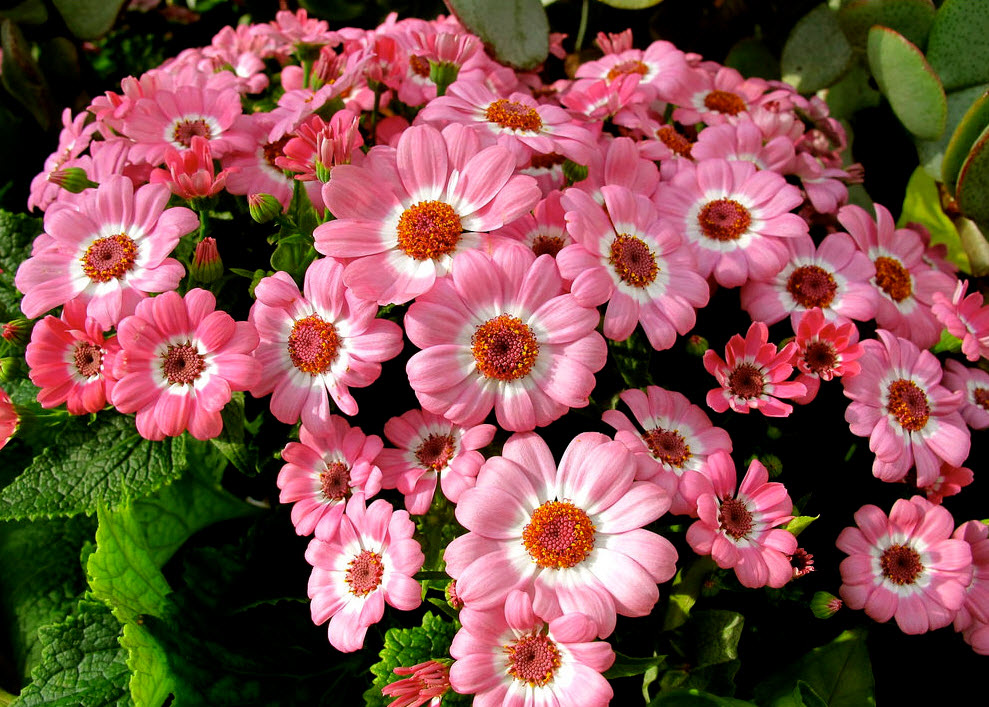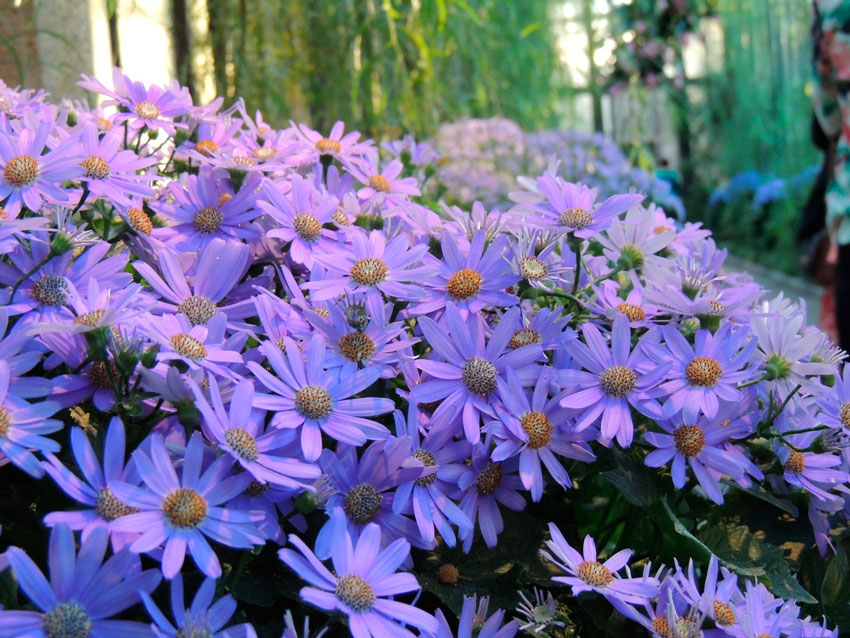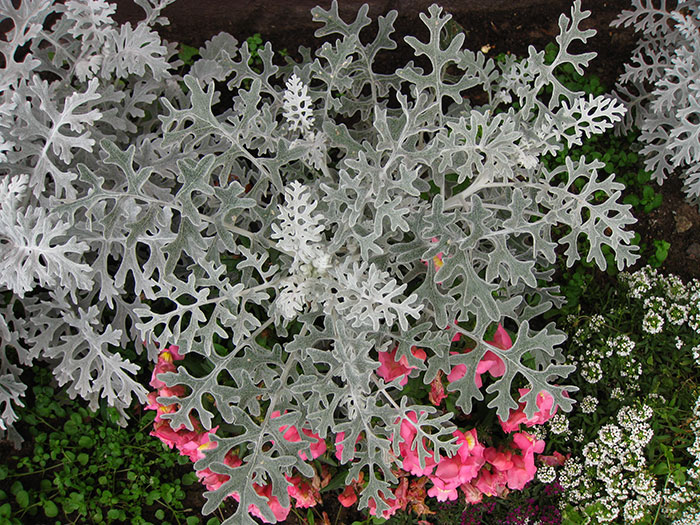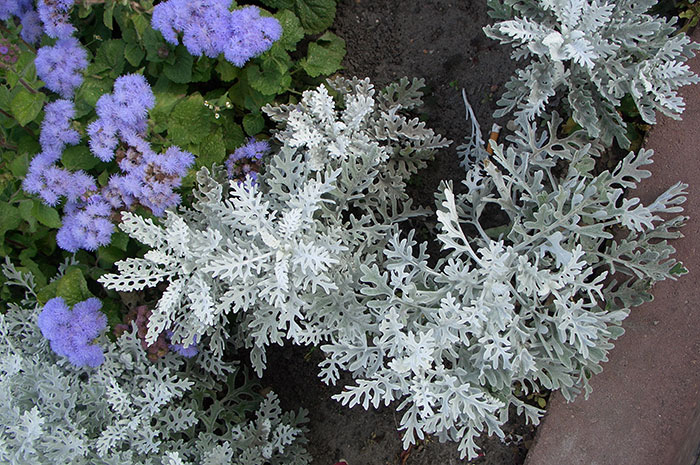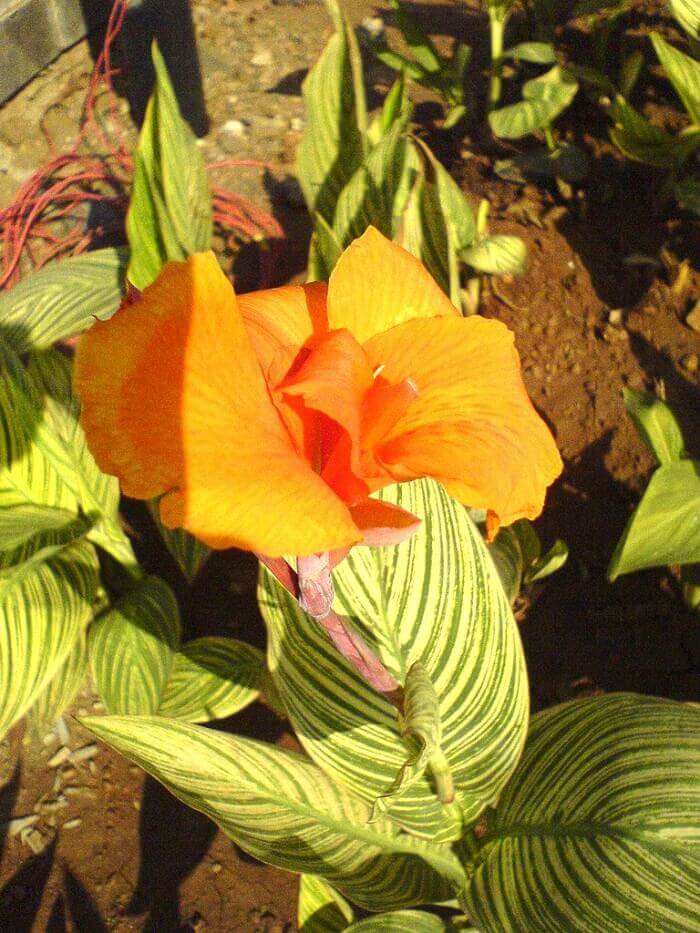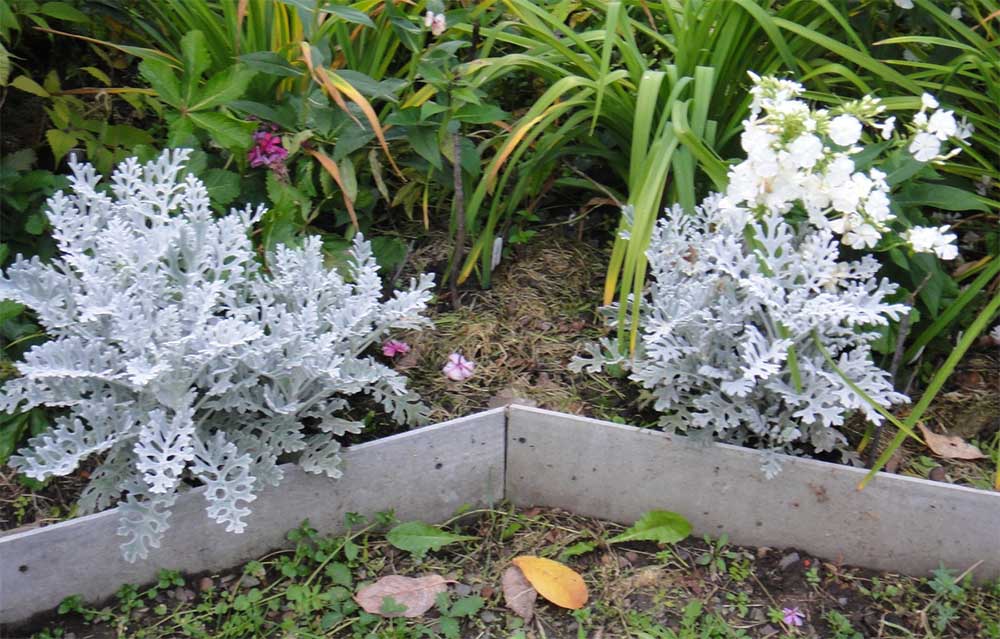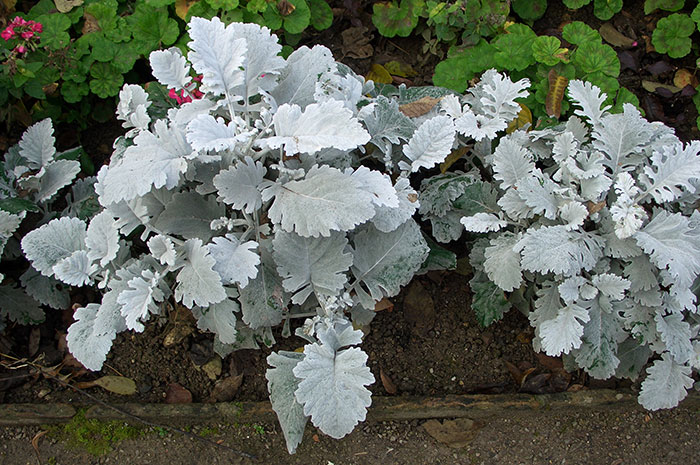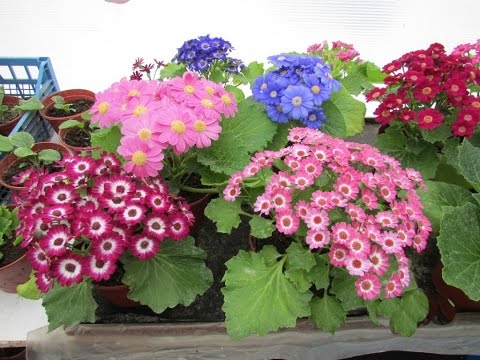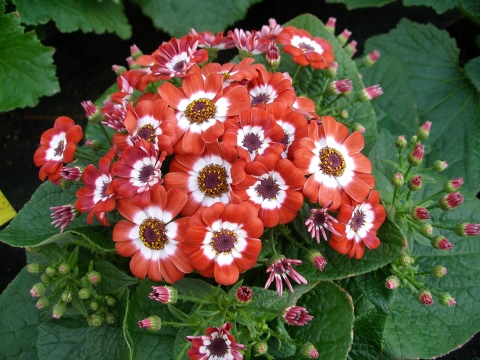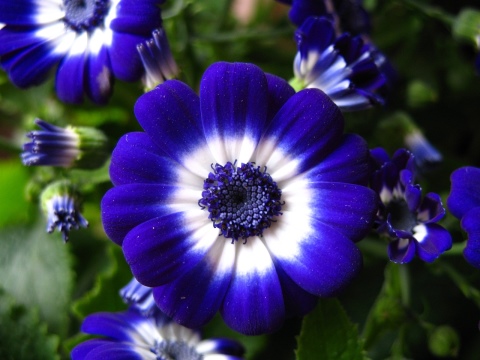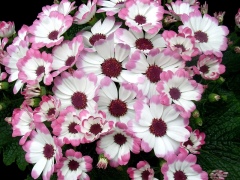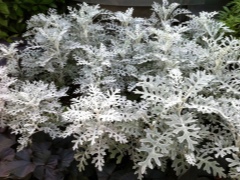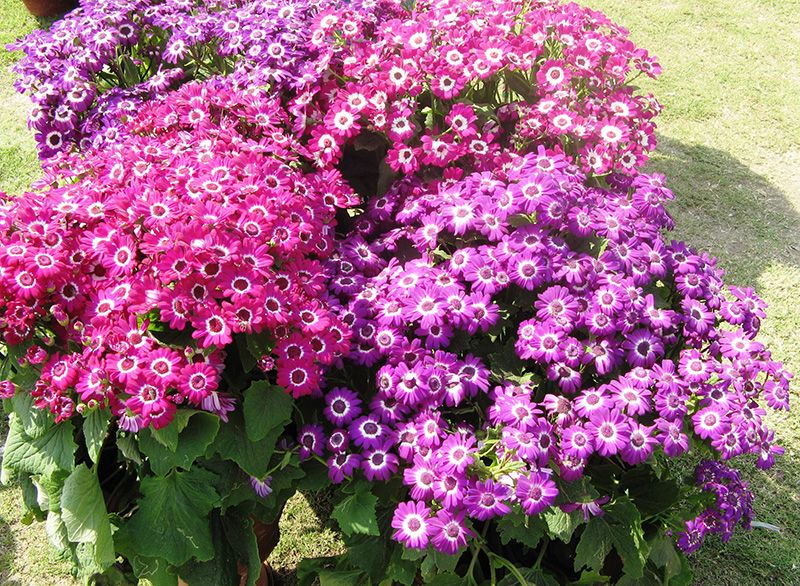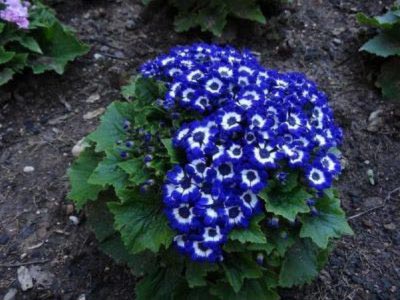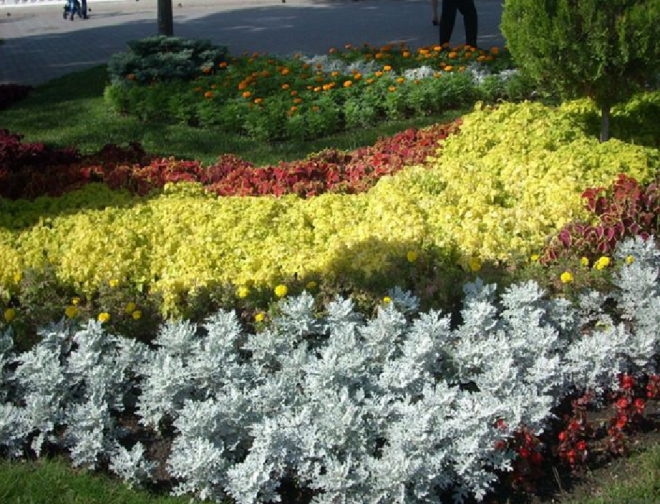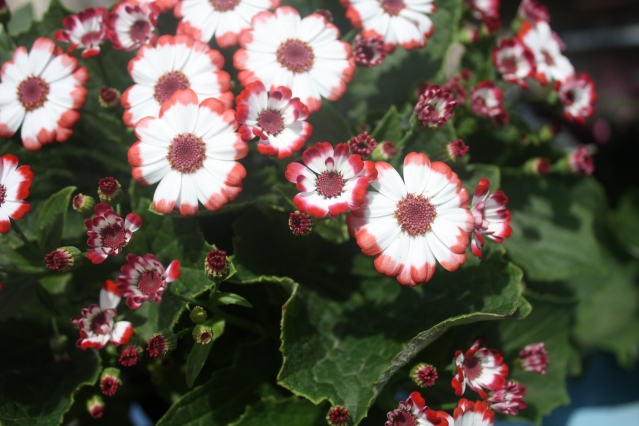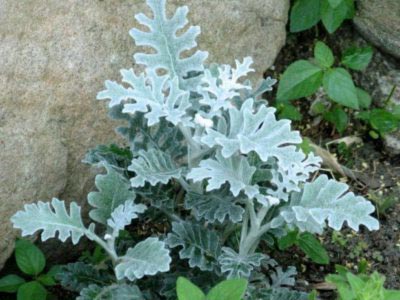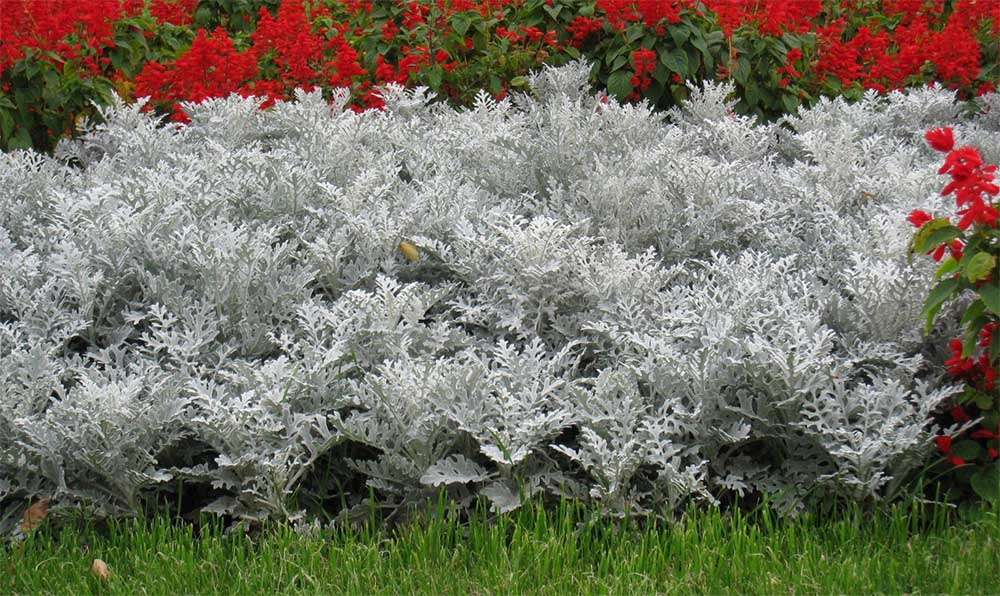Cineraria in landscape design
Due to its compactness and bright color of the baskets, flowering cineraria is often used to decorate the front tier of a flower bed or border. Balconies, terraces and verandas are decorated with blooming potted cineraria. They are successfully used in mixed flower beds next to other plants or create a mix of cineraria of different colors alone. The best partners for this plant are marigolds, phloxes, petunias, celosias, coleus, begonias, ageratums, balsams, lobelias and salvias.
Silvery cineraria is planted in crevices of masonry or as a decorative border against a background of bright flowers.
Cineraria - planting and care
This plant is grown in the form of subshrubs or herbaceous flowers, which vary greatly in color of petals and shape of leaves. In addition to flowering forms, there are decorative deciduous species with an elegant silvery crown. For the house, an indoor cineraria flower with a height of 30 cm was bred, and in the open field you can plant bushes up to 90 cm in size with powerful taproots. The leaves of the plant are covered with soft villi with a bluish tint. In summer, cineraria throws out beautiful inflorescence baskets with double and simple flowers.
Types of cineraria popular in Europe:
- Cineraria bloody (hybrid, red) - up to 70-90 cm high, excellent for indoor cultivation, has bright openwork decorative foliage and buds with petals of the most varied colors. Common varieties of bloody cineraria flower are Double, Sympathy, Grandiflora, Stellata.
- Cineraria graceful - grows as a spherical shrub 20-60 cm high, depending on the variety. The varietal group Ligulosus has double flowers, and the popular varietal dwarf group Nanus is famous for its bright pale pink petals with a burgundy core.
- Cineraria silvery (seaside) - in the southern regions it is grown as a perennial, in a temperate climate - as an annual crop. This species is famous not for the flowers, which are removed before blooming, but for the unusually decorative ash-silver foliage.
Cineraria in landscape design
A beautiful flower is used both for decorating their windowsills and for personal plots. Cineraria in the garden can be planted in flower beds and serve as a decoration for gazebos. This the flower is great for different garden design. The plant can be planted near paths and in different compositions, in a bed and on a lawn. Seaside cineraria is an excellent solution for curbs.
Cineraria - what to combine with in a flower bed?
Bright flowers are ideal both in single plantings and in combination with other plants. When planting cineraria in a flower bed with other flowers, in most cases, they are planted along the edge, as a bright frame. Species that grow up to 0.5 m can be combined with other Astera. Keep in mind that almost all varieties of cineraria require sufficient lighting to care for, so when planting, select companions that will not create shadows.
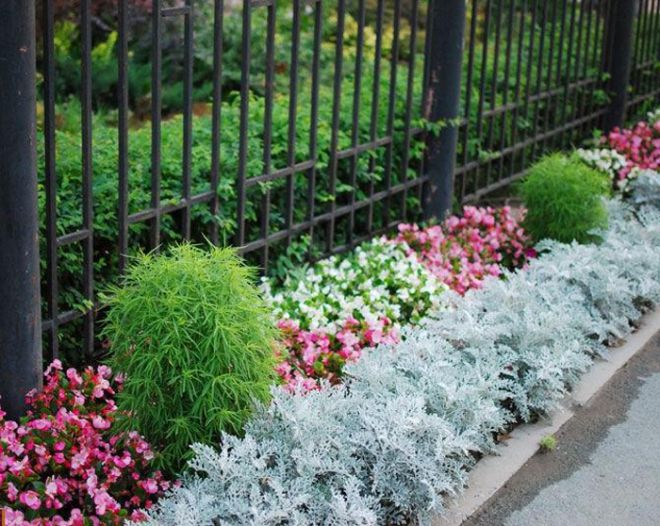
From whom to protect cineraria
First of all, from fungal diseases. Coolness and high humidity are very suitable conditions for powdery mildew, blackleg and various rot. For prevention, the following methods are used:
- disinfect the soil before planting the plant with a pink solution of potassium permanganate;
- carefully monitor the amount of irrigation water in the pot;
- drain excess water from the pan;
- do not allow waterlogging;
- ventilate the room.
Of the sucking arthropods on cineraria, one can find aphids, spider mites, and thrips.Treatment with "Aktellik" is effective against them in the dose and with the frequency indicated on the drug label.
Bloody cineraria is good in that it is able to decorate the most dull winter months, when, among cloudy days, you so want to see bright colors. Carefully monitor the moisture content of the soil, cut out wilted leaves and inflorescences, protect the beauty from drafts - and a dense bouquet of shining flowers will cheer you up every morning.
Cineraria from seeds - long and exciting
The main condition for the growth of healthy seedlings of bloody cineraria is coolness. She loves that the air temperature does not rise above 20 degrees. For sowing, take an ordinary seedling box, fill it loosely with fertile soil, moisten it, press the grooves with the edge of the ruler and sprinkle seeds in them
Then, with the same ruler, carefully level the soil. The box must be covered with glass and periodically ventilated
Seedlings of cineraria will appear in two weeks. When the first true leaf unfolds, the seedlings dive so that now there is at least 5 cm of distance between them. If possible, the temperature is lowered to 10-12 degrees. This cooling stimulates the plant to form abundant flower buds.

After waiting for the leaves of neighboring plants to close the rows, the seedlings are placed in pots, deepening the petioles of the lower leaves, or they begin to decorate flower beds with cineraria.
Diseases and pests of cineraria
Diseases of cineraria and their treatment
Cineraria in the garden can get sick with late blight, rust or powdery mildew.
Late blight is a fungal disease that most often affects nightshade crops, so try not to grow cineraria next to potato, tomato, eggplant, or pepper beds. The infection is activated in conditions of high humidity. The symptoms of the disease are brown spots on the leaves of the plant. Plants wither with the development of late blight. As soon as signs of the disease appear, the affected specimens are immediately removed from the site and burned, and healthy cineraria are abundantly sprayed with a three percent solution of copper sulfate. The soil in which the diseased bushes grew is also spilled with a solution of vitriol, dug up and spilled with a solution of a tablespoon of Fitosporin-M in a bucket of water. Nothing can be grown in this place for at least two years.
Powdery mildew is a common gardening disease of a fungal nature. It manifests itself as a whitish bloom on the leaves and stems of plants. Over time, the plaque becomes denser and brownish. The affected areas stop developing, turn black and die off. Plants lose their decorative effect. Infection usually begins at the beginning of summer, the infection is activated against the background of sudden changes in temperature and humidity, and a factor such as an increased concentration of nitrogen fertilizers in the soil contributes to the rapid development of the disease. At the first signs of the disease, the affected leaves are cut off, and the plants and the soil under them are treated with Topsin, Topaz, Fundazol, Quadris, Tiovit Jet or Bayleton. It is better to pull out heavily affected specimens and burn them.
Rust is also a fungal disease. You can recognize it by the appearance of characteristic formations of a rusty color on the underside of the sheet plate. When these red pustules crack, the spores of the fungus spill out and are carried by the wind and insects to other plants. On the upper side of the leaves, pustules are projected with light yellow spots. Rust causes increased transpiration (evaporation of moisture), causing the plant to dry out and die. You can destroy the infection by treating plants and soil on the site with Topaz, Cuproxat, Strobi, Vectra or Bordeaux mixture, which is carried out 2-3 times after 10 days.
Pests of cineraria and the fight against them
Cineraria in a flower bed can suffer from spider mites, aphids and whiteflies. All of these pests are sucking.They bite through the delicate tissue of leaves and young shoots and feed on their sap.
Whiteflies are small white moths that resemble moths. They settle on the underside of the leaves and, if you move the bush, they soar above the plant in a white cloud. As a result of the vital activity of whiteflies, plants become lethargic, their development slows down, and then leaf chlorosis develops in them. Whitefly feces are a favorable environment for all kinds of fungi, which clog the pores of tissues, which interferes with the process of photosynthesis. With a small number of pests, they are cleaned from the underside of the leaves with a brush dipped in soapy water, but if the whiteflies have bred, treat the bushes with a solution of 1 g of Aktara in 1 liter of water.
Spider mites are frequent guests in a flowerbed with cineraria, as they prefer to settle on drought-resistant plants. In places where they bite, tiny discolored areas remain on the leaves. The leaves gradually acquire a mosaic color and die off. Fighting ticks is difficult, so do not waste time trying to cope with these pests using traditional methods. The best way to get rid of ticks is to treat cineraria on the leaves with a solution of acaricide (ticks are not insects, but arachnids), for example, Actellika, Fitoverma or Neorona.
Aphids, feeding on the cell sap of cineraria, weakens the plant. Cineraria begins to lag behind in growth and development, its young shoots are deformed, the leaves turn yellow, wither, larvae and adult aphids accumulate on their underside. The excrement of this pest is a honeydew - an environment for the development of various fungal infections, including a sooty fungus that covers the leaves with an ugly black bloom. In addition, aphids, like other sucking pests, are carriers of incurable viral diseases. Aphids are destroyed in the same ways as whiteflies.
Ash groundwort: varieties and varieties
Often the ash-tree is cultivated as an annual. Planting and caring for the plant is carried out as usual without any requirements. Widespread in Europe. His homeland is the Mediterranean.
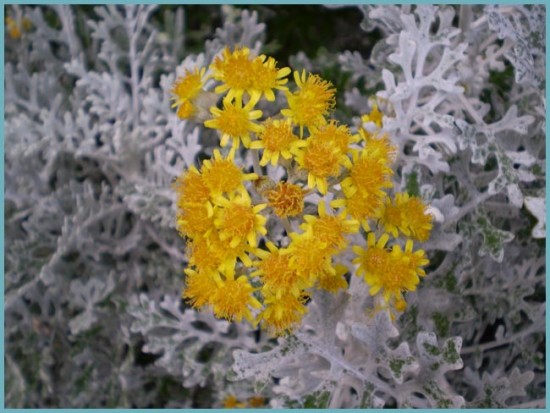 Cineraria silvery is more often grown for unusual leaves rather than flowers.
Cineraria silvery is more often grown for unusual leaves rather than flowers.
The variety of cineraria has about 50 varieties. Initially, the flower grew on the African continent and the island of Madagascar, and gradually moved to our latitudes. It is not surprising, because this beautiful plant takes root and reproduces well.
-
Cineraria is silvery. She is an ash-tree and a seaside jacob. This is a small shrub no more than 30 cm high. This type of cineraria is famous for its openwork fluffy leaves. The culture blooms with yellow flowers, but they are usually cut off, since they spoil the appearance when combined with other plants. Cineraria silvery has many varieties, but the most famous among them are Cirrus and Silver Dust.
Cineraria silvery
-
Cineraria is graceful. Perennial. Prone to strong overgrowth. Flowering pleases with various variations of colors. The flowers have blue, purple and other petals. This type has been used to create bouquets of long-term storage.
Cineraria graceful
-
Bloody cineraria. A small annual, which is grown not only in the open field, but also indoors, as well as balconies and terraces. It has light green leaves and double petals.
Cineraria bloody
Propagation methods
Cineraria reproduce in several ways - by seeds and vegetatively.
Growing from seeds at home
Ornamental varieties with beautiful flowers grow from seeds, and they often do not reproduce in another way. Seeds are sown for seedlings in late March - early April, and it is quite simple to care for them: after the first shoots appear, you need to dive and water moderately so that the soil is always slightly moist.Seed germination is high enough. The sowing itself is carried out not in the hole, but with the help of a light soil covering. For the first weeks until the emergence of shoots, cover the pot with foil or glass to create a greenhouse effect.
Propagation by cuttings
Not all varieties reproduce by cuttings, therefore, before breeding a roseberry, you need to familiarize yourself with the features of its specific varieties. Basically, with the help of cuttings, you can breed plants with decorative greenery. To do this, an apical branch 8-10 cm long is carefully cut off from an adult bush and placed in water until the roots appear. Cuttings are usually carried out in mid-August.
Division of bushes
You can also propagate the crosswort by dividing the bushes - but in this case, you need to start work before the flowering of the plant
At first, it is carefully dug, while you need to take care not to damage the root system, which is usually not very strong.
When a bush breaks, it is important to ensure that each half has sufficiently dense roots.
Advice! It is better to sprinkle the injured places of the bush with ash and let it dry for 2-3 days, after which you can plant it - this way they will take root much faster.

You can propagate the groundwort by dividing the bushes.

